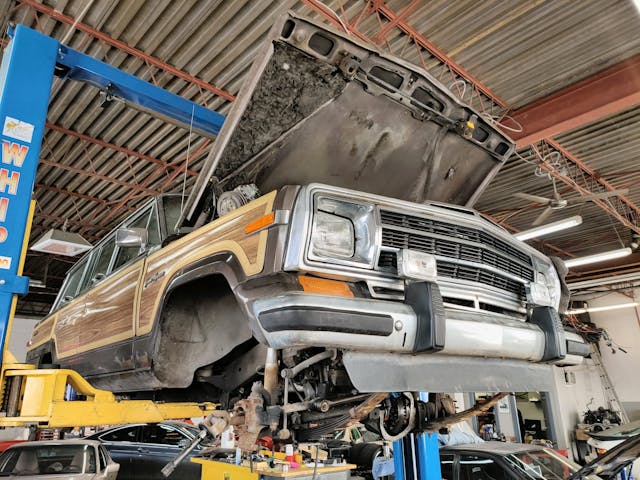Wagoneer engine swap: The long view through Jeep project hell
There’s a certain point in which a short-term project makes the subtle yet emotionally wrenching transition to a long-term saga. Some of you may know this place as “project hell,” and it usually manifests itself when so many unforeseen issues have piled up that the original timeline has been thrown out the window and you now need a pair of binoculars to even see the finish line.
For my 1987 Jeep Grand Wagoneer (which is currently entering its eighth month of what was envisioned as a winter-long LS swap), Project Hell status activated in the midst of a global pandemic that almost entirely shut down the resources needed to get the SUV back on the road.
In the grand scheme of things, to be sure, this was a small frustration. When people are dying and economies are crumbling, a stalled build sits well down on the list of essential priorities. In the context of the project itself, however, the pandemic time-out was a fitting capper on several months of the one-step forward-two-steps-back learning process that has so far defined my LS engine swap experience. The entire endeavor is becoming an object lesson in how nothing is as straightforward as it first seems when modernizing a vintage truck.
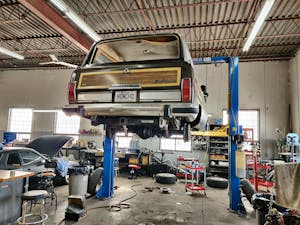
Worse than I thought
After the original owner flim-flammed me about the condition of the 5.3-liter donor engine (which turned out to have a bent rod), I was eager to get the New Year started off right. That meant a January trip to TK Race Engines in Laval, Quebec, to have the hydrolocked block torn down so that the pistons could be replaced.
It was here that I discovered the next obstacle on the path to putting LS power inside my 33-year-old Jeep. TK’s owner, Tom Kolimatsis, quickly determined that the piston-to-cylinder-wall clearance in the engine was measuring .004 inches, which is decidedly terrible when factory tolerances are listed at .0027 inches. Not only had I’d been lied to about the condition of the motor I bought, but the professed mileage was also likely fudged. With that much wear, there was no way the odometer reading the prior owner provided was anywhere close to accurate. It also meant that the set of used pistons and rods I’d purchased for a song ($75) from a local LS builder weren’t going to solve this problem.
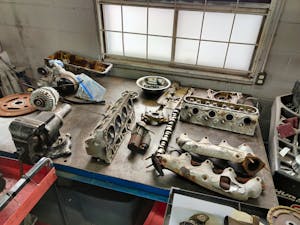
“Let me put it to you this way,” Kolimatsis said to me over the phone. “Yeah, I could rebuild the motor using these stock pistons, but within 5000 miles you’d be dealing with oil leaks.”
The secondhand rods themselves could work, but it was time to bore the cylinders and move to .020 inch oversized pistons and rings in order to get back to an acceptable level of clearance. It came out to $360 for the set, combined with a Clevite main and rod bearing kit ($92), a timing chain kit that came with a new oil pump ($84), and a set of main bolts from Summit ($190), all of which were necessary to do the job. Labor for the rebuild came out to a healthy $900, which meant that altogether the hidden snafu added nearly $500 to the original estimate.
Fits like factory
At the very least, once the refreshed engine was back at AGM Performance, there were no further issues in fitting it inside my Grand Wagoneer’s engine bay (aside from a bit of tightness between the exhaust manifolds and steering shaft). Given that I had decided to retain the stock heating and air conditioning system, which was mounted on the firewall, some creativity around battery placement became necessary. Eventually, by rotating the original battery pan to clear the newer and much thicker radiator, Andrew Grubb and his team were able to sit it below the hood. Grubb also fabricated a fan shroud for the electric Ford Taurus fan used to help keep the truck cool ($140) and an air intake that snaked its way from the front of the motor to the air gap on the passenger side.
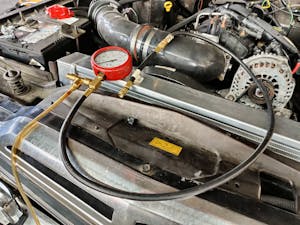
All of this positive momentum had us riding high, but that euphoric feeling was quickly squelched by a fairly major issue: once the 5.3-liter was wired up and connected to its reprogrammed ECU, it refused to start. To say this was puzzling was an understatement, as running power to individual components provided us with both spark and fuel. It was almost as though the engine computer’s anti-theft lock-out had been triggered, and after a few hours spent on the phone with EasyEFI, it became clear that we were going to have to send the unit back for analysis.
Domino meets domino meets domino
It’s here that part one of the waiting game began. While it didn’t seem important at the time, the wasted week spent trying to diagnose the Jeep’s no-start condition, coupled with the two weeks it took to get the computer back in our hands (with considerable shipping and customs fees attached thanks to its repeat border crossing) would play a major role in shutting down the project cold.
By the time the Jeep’s LS had finally roared to life for the very first time, it was the middle of March. Two weeks later, the provincial government in Quebec ordered all non-essential businesses closed as a result of COVID-19, which meant that the order we had just placed for the custom driveshafts ($840) required to connect the NP241C transfer case to the Grand Wagoneer’s axles was in indefinite limbo.

Oh, and that computer problem? It turns out that the original programmer had simply “forgot to hit save” after reflashing it the first time. If you’re keeping score at home, yes, that means everyone had wasted considerable shop hours trying to start the LS with a computer that still thought it was linked to a 2008 Chevrolet Tahoe, including all of its irrelevant sensors and security protocols. In the process, my mechanic and I also discovered that the motor—or at the very least, the computer—was actually an LY5 rather than an LMG, with the sole difference being that the latter could operate on Flex Fuel if required.
Baby steps toward oblivion
By mid-April, a small bit of good news arrived. Auto mechanics had been declared an essential service in Quebec, which meant that smaller shops were able to re-open as long as they followed the required health protocols. A few weeks after that, my mechanic checked in on the driveshaft shop and was told that my order was in the queue. A couple weeks after that … and you can see where this is going.
Surprisingly, I learned that the shop sitting on my order was only working on “emergency driveshafts,” which was news to me and required clearing up with the well-meaning but largely absentee owner. Five days later, the shafts had been delivered, which meant the project could once again pick up after a delay of nearly a month and a half.
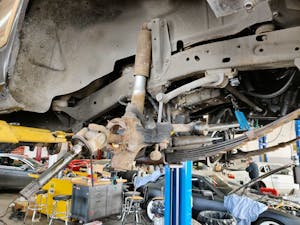
Driveshafts were the final piece of the puzzle in terms of transforming my Jeep from an idling paperweight to an actual, moving vehicle. After so many weeks of waiting, it was more than a little irritating to discover that the front driveshaft had mistakenly been built for the wrong transfer case, requiring a completely different attachment point. Still, it wasn’t the end of the world, and it seemed like a good idea to install just the rear driveshaft so I could put some miles on the Jeep and start to work out any bugs that appeared along the way.
Despite every setback that had occurred so far, I was optimistic. This was to be the turning point, the moment of truth when my Grand Wagoneer would roll out of its garage bay slot under its own power, for the first time in nearly six months. With the rear shaft installed and the truck running, the transmission shifted into gear and…nothing. Despite the muffled sound of gears churning internally, no motion whatsoever was being transferred to either the shaft or the differential.
After a flurry of frantic Internet research and troubleshooting, the problem came into focus. My fear of a bent-and-bad transmission (whose internal condition was still a mystery) were allayed in light of the discovery that the NP241c had come with two different input shaft sizes. My mechanic and I were lucky enough to have the rarest of them all (the larger of the two) which would have to be swapped out (along with a bearing) in order to make my Jeep mobile.
The never-ending story
I had fully intended this to be the section of my engine swap diary entry where I told you what it felt like to finally drive my Grand Wagoneer at full gallop, with a revitalized LS pumping out three times the SUV’s original power and providing the classic platform with the modern heartbeat it deserves.
Given all the obstacles to that goal, you probably won’t be surprised to learn that I have yet to taste such victory. Yes, the Jeep now runs and drives around the shop rather than having to be pushed out of the way—but only just. The current task is chasing down an intermittent stalling issue and a crankshaft position code that’s keeping the motor in “safe” mode, restricting its output and making further tuning difficult. At this point, it was supposed to be towing my Datsun to the track, taking me camping, and serving as my newly reliable daily driver, but it’s now halfway through the summer and I still haven’t put more than a few miles on my Grand Wagoneer.

I’d be lying if I said I wasn’t disappointed by the many different twists and turns toward the dark side that this project has taken. There have been more than a few moments over the last few months where I’ve beaten myself up about all of the cash and time that the Jeep has eaten up, particularly as I browse online classifieds and am confronted by all of the (seemingly) problem-free vehicles I could have bought with what I’ve now spent chasing a quixotic LS dream.
Still, all it takes to steer me back toward the sunlight is to visit the automotive infirmary where my Jeep currently sits. Standing there in its presence, inhaling its outgassing plastics, and running my hand along its weathered paint and “wood” paneling, I’m reminded of all the reasons why I began this by-now arduous project in the first place. Even on the days where I’m wishing I could just walk away from it all, a quick trip to the shop reignites my passion for the build and reminds me that although the path I’ve chosen to walk might be a foolish one in the purely logical sense, it’s at the very least also been a conscious one. As with most decisions to pursue classic vehicle ownership, sometimes when the heart leads, you can’t predict what turns the path will take.
